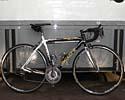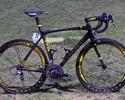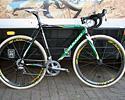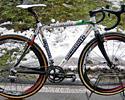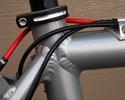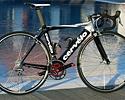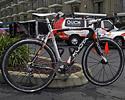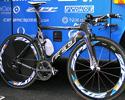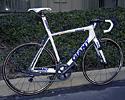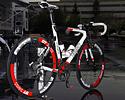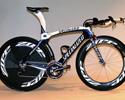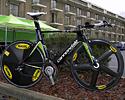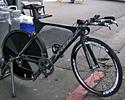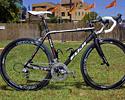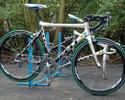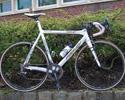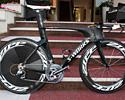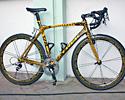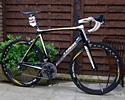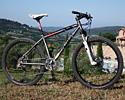
Recently on Cyclingnews.com |
2009 Pro Team bikes
This year's models
Welcome to Cyclingnews' 2009 pro bike section; a look at what the professionals will be riding this season. During the 2009 year, we'll bring you a selection of images and specifications of the latest and hottest bikes.
Mark Cavendish's Team Columbia Scott Addict
Scott Bicycles admittedly had a rough time last year what with the fiasco surrounding Saunier Duval-Scott stars Riccardo Riccò and Leonardo Piepoli at last year's Tour de France. The 2009 season is looking far brighter, though, as they have now realigned themselves with not only one of the winningest teams in the sport but also one with a squeaky-clean image: Team Columbia. In total, Columbia riders scored over eighty wins in 2008, stood on the podium a staggering 153 times in total, took home five stage wins in the Tour de France - four by British superstar sprinter Mark Cavendish alone - and even enjoyed an extended stint in yellow courtesy of Kim Kirchen. Not bad for a team that many wrote off barely a year ago before being resurrected by new owner Bob Stapleton. To read the full article, click here. |
|
Wim Stroetinga's Milram Focus Izalco
Team Milram's Wim Stroetinga is best known as a member of the Dutch national track squad. The 23-year-old from Drachten has ridden for several continental teams since 2005 and makes the jump to the ProTour with Milram for the 2009 season. Riding his first Tour Down Under, Stroetinga will be on board one of the German squad's new Focus Izalco frames, which were unveiled in team livery during Milram's presentation in Dortmund earlier this month. The German company initiated its sponsorship after the relationship with long-term technical partner Colnago ended was ended following the 2008 season. The fact that Rabobank has also switched to another manufacturer means that Colnago is no longer represented in the ProTour peloton... but that's another story for another time. To read the full article, click here. |
|
Lance Armstrong's Trek Madone 6.9 Livestrong
One of the first observations Trek’s team liaison Ben Coates tells Cyclingnews about is the number of fellow pro riders that ask to be photographed with Lance Armstrong’s Trek Madone 6.9, complete with Livestrong livery. Astana team mechanic Chris agrees, as he checks the weight of the rig. "Seven twenty six," says Chris to Silence-Lotto mechanic Steven in Flemish. They then discuss the various aspects of Lance’s bike compared to Matt Lloyd’s Silence-Lotto Canyon, the bike I have just been measuring and photographing for this section of Cyclingnews. It’s a nice exchange between two experienced wrenchers who have seen most of the bike exotica the pro peloton has on offer. "This is a stock bike, we pulled it right off the line," says Coates. "There’s no special person that builds Lance’s bikes, no special process they go through... Someone went to the back of the factory in Waterloo, Wisconsin and took the bike off the line and painted it up." To read the full article, click here. |
|
Sven Nys' Landbouwkrediet-Tonnisteiner Colnago C50 Cross
Sven Nys had ridden his whole career with Rabobank but took the decision to switch to the smaller Belgian Landbouwkrediet-Tonnisteiner team at the beginning of this cyclo-cross season. Part of this decision was due to his dissatisfaction with his old team, but a lot was also down to the fact that the Kannibal of cross wanted to take a proper tilt at the road in 2009 with the ambition of winning the Ronde van Vlaanderen right up at the top of his wish list. A team change usually comes with a switch in bikes and getting used to the characteristics of a new frame can take some time. Not so for Sven Nys. As luck (or design) would have it, his new team also rides frames made by Colnago and so all the Belgian champion had to do was get used to a new colour. Ernesto Colnago and Nys have long enjoyed a fruitful relationship, which would recently have come to an end had Nys stayed with Rabobank who are switching to Giant for 2009. The Italian master builder actually created a frame especially for the Belgian called the "Cross Prestige", but Nys actually prefers to stick to the machine that has carried him to so much success over the years: his custom built C50. To read the full article, click here. |
|
Marco Aurelio Fontana's Guerciotti X-Crow
Italian cyclo-cross sensation Marco Aurelio Fontana (Selle Italia Guerciotti A.S.D.) has won a number of junior and U23 national titles in both cyclo-cross and cross-country mountain bike disciplines during his still-budding career but says nothing compares to the Italian national 'cross championship he won in January 2008 in Scorze. "Winning the national championship was an incredible sensation because it makes you feel like you are the strongest rider in Italy," said Fontana. "All the other titles have no value anymore. Now people see me as a national champion and no longer as the kid who used to bunny hop barriers and pop wheelies at the finish line." After winning the national title, Fontana continued to add to his resume with a solid sixth place finish at the 2008 UCI Cyclo-cross World Championships followed by a fifth place at the Beijing Olympic Games in the cross-country mountain bike race. To read the full article, click here. |
|
Katie Compton's Primus Mootry
Katie Compton is enjoying her most successful cyclo-cross season to date. She has proudly paraded her US national champion's jersey - which she won for a fifth successive time this season - on many podiums, including the top step at three World Cups; Koksijde in Belgium, and Nommay and Roubaix in France. As one of the big favourites for this weekend's UCI World Championships in Hoogerheide, the Netherlands, Compton is hoping to ultimately trade in her stars-and-stripes jersey for her first rainbow one. The similarly red, (sort of) white and blue Primus Mootry frames that Compton has been using to take on the best riders in Europe this winter have been a familiar sight to onlookers but they are not only the identical models as what she rode in last season's campaign, they're the same frames. To read the full article, click here. |
|
Carlos Sastre's Cervélo S3
Carlos Sastre became one of the hottest tickets in cycling after winning the Tour de France last year. The news that he was on the market for a new team led to several offers, including one from the big-bucks Katusha squad, but Sastre ultimately opted to go with the new Cervélo TestTeam. Citing the opportunity to be more involved in new product development, Sastre said he was looking forward to giving his feedback to Cervélo and the other partners. "It is a new project which fits very well with my way of being," he said in September. "It offers the opportunity to open frontiers and collaborate more actively with our sponsors and their clients. At the same time, we can contribute more efficiently to improving the technology of our materials." To read the full article, click here. |
|
Ivan Basso's Liquigas Cannondale SuperSix Hi-Mod prototype
This year, Ivan Basso will not only focus on his performance on the bike but also the performance of the bike as he will play a key role to the engineers at team sponsor Cannondale as they develop the next generation of its flagship SuperSix Hi-Mod full carbon road frame. According to Basso, testing is well under way and the team has already received several iterations. "It's a really fantastic bike," said Basso. "It is lighter and very stiff. I had a good feeling immediately," said Basso. "I've never used Cannondale. I've ridden for many years and I've always used my team-sponsored bike. So, I've never come across a Cannondale in the past. To read the full article, click here. |
|
Alexandre Moos’ BMC TT01 Time Machine
BMC has high hopes for this year’s Tour of California after an impressive showing in 2008 by riders such as Scott Nydam (winner of the mountains classification) and former Swiss national road champion Alexandre Moos (tenth overall, fourth in the mountains classification). A pro since 1997, veteran Moos brings valuable experience to the relatively young squad, but his history with BMC - he was also with Phonak - and Swiss background also nets him a closer relationship with the team’s bike sponsor. Moos’ teammates will all use BMC’s second-tier TT02 Time Machine for the time trials at this year’s Tour of California but Moos has been provided with the full-blown TT01 flagship. To read the full article, click here. |
|
Floyd Landis' OUCH Pro Cycling Team p/b Maxxis Kuota Kredo Ultra
Floyd Landis has returned to the sport this season though the stage on which he is competing isn't quite as grand as it was when he left. Landis and his OUCH Pro Cycling Team squad are concentrating solely on U.S. domestic events - not the European theatre he was once accustomed to - with the Tour of California being his biggest show of the year and his one shot at proving his mettle against some of the world's best riders. Landis is sure to put in some massive efforts as the race winds its way to the finish in Escondido and appears to be on an appropriate machine for the job in the Kuota Kredo Ultra. Kuota has earned a reputation for using enormously oversized tube sections for extra frame rigidity and the Kredo Ultra's overgrown proportions look to provide a suitably stout platform for putting down the power. The front triangle is particularly overgrown starting with a bottom bracket area that comes up nearly level with the large chainring. Integrated BB30 bearings allow for a larger-diameter bottom bracket spindle than usual, too, while also offering a generous amount of ankle clearance. To read the full article, click here. |
|
Francisco Mancebo's Rock Racing Kestrel RT 800
Rock Racing enjoyed a bit of a respite from the latest controversy surrounding the team's long-term viability with a well-earned victory by Francisco Mancebo. Mancebo made a lone breakaway from the peloton after just 5km - leaving a foreboding 167km to the finish in Santa Rosa - yet still had enough energy remaining at the end to outsprint Vincenzo Nibali (Liquigas) and Jurgen Van Der Waale (Quick Step) just 500m from the finish. Making the win even more impressive is the fact that the team had supposedly only received their race bikes from new sponsor Kestrel just before the race started so Mancebo had little time to get acquainted. Mancebo's new Kestrel RT 800 road machine comprises a decidedly unusual mix of curves, angles and creases that stand in stark contrast to the smooth and highly organic shapes that once defined the brand. The moderately oversized, slightly sloping top tube and nominally aero-shaped down tube appear to completely envelop the ends of the head tube while the seat tube sports a deep cross-section and modest rear wheel cutout. Kestrel fits consumer versions with a matching aero-shaped carbon post, too, though the team has opted for the round seatpost option here. To read the full article, click here. |
|
Christian Vande Velde’s Garmin-Slipstream p/b Chipotle Felt F1 SL
Christian Vande Velde once considered himself more of a super domestique than an overall contender but after last year’s breakout performances at the Tour de France and Giro d’Italia, 2009 now brings bigger and better goals starting with the Tour of California. Carrying him on the road stages from the start in Sacramento to the finish in Escondido is Felt’s flagship F1 SL. The F1 SL is Felt’s classic level top tube frame, trading the aerodynamic performance of its latest AR and the Z’s smoother ride and more stable handling in exchange for lighter weight and snappier handling. Interestingly, Felt’s lightest road frame bears their oldest carbon shape yet continuous advances in materials and construction technologies have kept it current. Thanks in part to Felt’s latest Ultra-Hybrid Carbon fiber blend and carbon nanotube-enhanced resins, claimed frame weight is around 900g and the matching Felt 1.1 UHC-Nano fork adds just 300g more. To read the full article, click here. |
|
David Zabriskie's Garmin-Slipstream p/b Chipotle Felt DA
David Zabriskie hasn't earned his reputation as one of the best time trial riders in the world by being slow. He has earned four US national time trial titles (2004, 2006-2008), a silver medal at the UCI world TT championships (2006), and time trial victories in all three grand tours, including the fastest Tour de France time trial ever recorded (stage 1, 2005) with an average speed of 54.545km/h (33.89mph) over 24.5km (15.2mi). His position on a time trial bike stands in marked contrast to his famously quirky personality and to watch him gracefully hunkered down over a set of aero bars at speed is to watch the very epitome of what a time trialist should look like: long, low, fluid, graceful. In fact, his position is so perfect that former sponsor Cervélo actually had a plastic life-sized mockup of him built to aid in wind tunnel testing of its bikes. To read the full article, click here. |
|
Robert Gesink's Rabobank Giant TCR Advanced SL
The Tour of California has always been good to burgeoning 22 year-old talent Robert Gesink (Rabobank), who has now won the coveted white jersey of 'best young rider' for three years running. Gesink's white jersey is perhaps becoming a familiar sight to him these days, but this year's win fittingly came aboard a brand new bike. Giant replaces Colnago as the official Rabobank team sponsor this year and conveniently for Gesink and his teammates, the change also brings with it a brand-new iteration of Giant's long-running TCR carbon road racer, the TCR Advanced SL. Gesink's gleaming white TCR Advanced SL is a marked visual departure from his rather classic-looking lugged carbon Colnago with its far bigger tube profiles, sweeping curves and smooth lines. Though the old TCR was already no slouch in the weight and stiffness departments, Giant says this new one is a big leap forward. To read the full article, click here. |
|
Markus Zberg's BMC Racemaster SLX01
Markus Zberg's (BMC) BMC Racemaster SLX01 isn't the lightest bike in the Tour of California peloton at 7.41kg (16.2lb) but BMC says the primary goal in designing their latest road frameset wasn't shedding grams but rather maximizing stiffness. And it certainly takes a rather unique approach in doing so. While most other companies concentrate on tweaking their carbon construction methods, BMC has reverted back to aluminum for the SLX01. Hydroformed and triple-butted 7005 aluminum is used for the seat tube, bottom bracket shell, chain stays, dropouts, and majority of the down tube. To make for a more rigid backbone, the down tube runs the full width of the bottom bracket shell, the seat tube is similarly flared at its base, and the tall chain stays are widely set. However, BMC does use carbon for the Racemaster's top half, which includes the seat stays, T-shaped top tube, head tube, and part of the down tube in order to shave a few grams and add some rider comfort. Save for the bottom bracket shell, all of the other joints are bonded in place and the complete package is certainly distinctive, especially when wrapped in the special paint job to celebrate Zberg's Swiss national road title. To read the full article, click here. |
|
Fabian Cancellara's Specialized S-Works Transition
Fabian Cancellara was but a fleeting contender at this year's Tour of California having abandoned due to fever on just the second day but nevertheless left his mark on the event, seizing the first leader's jersey by winning the prologue time trial. World champion in 2006 and 2007, Cancellara is widely regarded as the
best time trialist in the sport and, until this year, used a Cervélo
P3 to clock up a multitude of victories against the clock. However a change
in bike partner for his Saxo Bank team also brings Specialized on board
as a new sponsor and and he'll now use their S-Works
Transition bike Specialized intentionally made the Transition's shape exceedingly narrow to provide as little frontal area as possible, starting first with the 1”-diameter fork steerer and narrow-yet-deep tube profiles that push the limits of the UCI technical rules. To read the full article, click here. |
|
David Kemp's Fly V Australia Parlee TT
Few small builders are in as elite company as Parlee Cycles, whose name is virtually synonymous with some of the finest - and most highly sought - carbon fiber frames available thanks to their uncanny blend of performance and ride quality. Even more rare are those riders fortunate enough to ride one for free such as David Kemp of Team Fly V Australia p/b Successful Living, a late addition to this year's Tour of California roster. Team members actually receive not just one but three Parlee frames to use for the season: two Z4 road models for training and racing plus Parlee's latest creation, the TT. We first saw the TT back at the 2007 Sea Otter Classic where it was still a development prototype but it is now ready for market and employs some proven aero bike technology: the head tube, down tube, seat tube, seat stays and seatpost all employ modified NACA airfoil cross sections; the seat tube sports a deep cutout to shield the rear wheel; the rear brake caliper is mounted down below the bottom bracket where the air is already 'dirty'; and the internally routed cables enter the frame at the top tube just behind the stem. All of the frame's trailing edges are also admirably sharp for a carbon frame. To read the full article, click here. |
|
Ivan Basso's Liquigas Cannondale Slice Hi-Mod
The Cannondale Slice Hi-Mod is one of the newer time trial shapes in the ProTour having first seen action in competition less than two years ago at the 2007 Giro d'Italia. Though late to the all-carbon TT bike game (the previous Six13 Slice used a mix of aluminum and carbon tubes), Cannondale at least enjoyed the benefit of already knowing what would work and what wouldn't. Proven aero technology on Basso's Slice Hi-Mod includes the deep 'Speed Shadow' rear wheel cutout, a more compact rear triangle for reduced frontal area, a slender horizontal top tube, and an aero fork whose crown integrates relatively tightly with the slightly dropped down tube. Of course, aero-profile tubing is used wherever applicable and the included deep-section carbon seatpost sports two offset positions to accommodate both time trial and triathlon events. To read the full article, click here. |
|
Matt Wilson's Team Type 1 Orbea Ordu
Team Type 1 rider Matt Wilson's Orbea Ordu is certainly one of the more distinctive time trial rigs on the circuit, eschewing smooth fluid curves for harder creases and sharper edges that are more reminiscent of a certain warbird than most other aero bikes. The aggressive lines start right up front with the Ordu's unique head tube treatment, which supposedly reduces drag while still offering the front-end rigidity and steering precision of a traditional 1 1/8" steerer. The hourglass profile transitions to an airflow profile in the midsection while the upper and lower portions smoothly blend into the top tube and down tube. The down tube's teardrop profile and the nominally level top tube's triangular cross-section are fairly conventional but the seat tube diamond shape is anything but. Orbea claim the four-sided shape offers a better combination of drag and frontal area than a typical airfoil - perhaps, but it looks keen either way. To read the full article, click here. |
|
Daniele Nardello's Fuji SL1
Sixteen-year veteran Daniele Nardello (Fuji-Servetto) will cap off his decorated career in the coming days with runs at some of cycling's hardest one-day races: De Panne, Ronde van Vlaanderen and Gent-Wevelgem. A professional since 1994, Nardello has seen his fair share of bikes built from a variety of materials. He spent most of his career on Colnagos having ridden for various incarnations of the old Mapei team for nine years, then a move to Telekom in 2003 meant a switch to Pinarello. Another switch - this time to Giant - came in 2004 as the squad became T-Mobile and he will now finish things off aboard a Fuji. Nardello has always been a man for the Classics with a powerful 1.81m and 73kg (5' 11", 161lb) build custom tailored for long, tough days in the saddle. Even so, team sponsor Fuji are confident enough in the strength of their flagship SL-1 to put him on their lightest machine as he attacks the cobbles. To read the full article, click here. |
|
Fabian Cancellara's Saxo Bank Specialized S-Works Tarmac SL2
Fabian Cancellara (Saxo Bank) hasn't changed allegiances from last year to this one in spite of a new team name, new colors and new kit. The team is still run by Bjarne Riis and most of the old Team CSC-Saxo Bank infrastructure is still in place but Cancellara has found himself with a new frameset and now even a whole different set of componentry for 2009 nonetheless. Specialized have stepped in as the team sponsor this year and Cancellara tackled this past Sunday's Ronde van Vlaanderen aboard the company's flagship S-Works Tarmac SL2. Though obviously differing in design philosophy from his old primary machine, the Cervélo SLC-SL, it does share some similar cues with his old R3 cobble-fighter. Like that R3, the Tarmac SL2's seat tube starts out round up top before transitioning to a more rectangular profile down by the bottom bracket and matches extra-tall and chunky chain stays to relatively slender seat stays to provide stout drivetrain response but also good comfort - undoubtedly a valued asset on Belgian cobbles. To read the full article, click here. |
|
Martijn Maaskant's Garmin-Slipstream Felt F1 Paris-Roubaix
At 24, Dutchman Martijn Maaskant (Garmin-Slipstream p/b Chipotle) could barely have asked for a better introduction to Paris-Roubaix, finishing a remarkable fourth in just his first outing in the queen of the Classics. Not surprisingly, Maaskant is now his team's undisputed leader for this Sunday as he attempts to place himself on the podium in '09 - ideally on the top step, accompanied by a mounted cobble. In addition to the rider support such a position entails, Garmin-Slipstream will have at least six bikes at the ready for Maaskant to accommodate mechanical failures and at least two of those machines are dedicated Paris-Roubaix rigs specially designed to deal with the unique rigours of the day. To read the full article, click here. |
|
Tom Boonen's Quick Step Specialized S-Works Roubaix SL2
Just how much is one rider worth to a bicycle sponsor? If that rider is Belgian superstar Tom Boonen and that company is Specialized, the answer is: quite a lot. Specialized had already developed one custom S-Works Tarmac SL2 geometry late in 2007 for Boonen's tall build with a longer top tube and shorter head tube. This not only allows him to stretch out more to develop full power but according to Boonen, also protects his sensitive lower back from injury. Unlike metallic frames, creating an altered geometry on a molded carbon frame requires more than simply adjusting miter points and weld jigs though – it entails careful engineering work to adjust lay-up schedules for the various plies and, of course, the creation of the mold itself. Add it all up and it's not exactly an inexpensive endeavour – all for one guy (well, two if you also include former teammate Gert Steegmans who happened to need the same fit). To read the full article, click here. |
|
Filippo Pozzato's Katusha Ridley Damocles Pi
Filippo Pozzato (Katusha) came oh-so-close to victory in last Sunday's stunning Paris-Roubaix finale, desperately chasing - but not quite able to catch - a fleeing Tom Boonen (Quick Step) after a dramatic series of late crashes found the Belgian star soloing into the Roubaix velodrome for victory for a third time. Still, Pozzato's second place finish was a superb result for the new Katusha team along with their Belgian sponsor, Ridley, who built a special Damocles Pi just for the Italian rider. Unlike some other custom machines in the Paris-Roubaix peloton that typically sported generous tire clearances, longer wheelbases and the like, though, this was no dedicated cobbles bike. In fact, at least as far as the frameset is concerned, Pozzato's Damocles Pi features not a single concession to Paris-Roubaix's brutal pavé and the custom geometry reads more like that of a typical road racer: the head tube is shorter than usual for a lower and more aggressive position; the top tube is longer - and also level in contrast to the stock version's sloping orientation - so that he can stretch out more; and the seat tube has a slightly slacker angle to better accommodate his generous 10.5cm of saddle setback. To read the full article, click here. |
|
Fabian Cancellara's Saxo Bank Specialized S-Works TTR prototype
Saxo Bank time trial and classics specialist Fabian Cancellara arrived at this year's Giro d'Italia with a brand-new aero prototype that he has been testing over the past several weeks. Currently nicknamed the Specialized S-Works TTR (for 'time trial Riis', according to team rider development manager Bobby Julich), the new bike's more organic shape is a drastically different machine from his previously more angular Transition. The TTR's most defining feature is undoubtedly the highly integrated front end. Whereas Specialized had previously angled the Transition's top tube to fall behind the stem in an effort to smooth out airflow, the TTR now sports a proprietary stem situated perfectly in-line with a now-level top tube similar to what Giant – and now Scott – have done with their latest aero machines. Extending below the stem and situated in front of the head tube is a secondary 'nosecone' that effectively increases the aspect ratio of the combined elements to far greater than 3:1, thus apparently skirting around the applicable UCI rule. Don't call it a fairing, though; while Felt and Giant apparently get away with their extensions because they either reinforce or are the steerer tube, Julich says that the TTR's nosecone should be considered a structural element because it provides the sole mounting point for the front brake. Cancellara's TTR also ditches the Transtion's kinked seat tube in favour of a slightly more conventional straight design with a deep rear wheel cut-out and easily adjustable telescoping carbon aero seatpost – which even sports an aero-shaped head. To read the full article, click here. |
|
Lance Armstrong's Trek Madone OCLV Red Series
Custom painted bikes have become the norm for Lance Armstrong (Astana) as he makes his return to professional cycling this year and his latest Trek Madone is quite possibly his most ornate to date. To commemorate Armstrong's first appearance at the Giro, contemporary artist Shepard Fairey - the man behind the infamous Barack Obama 'Hope' poster - designed an intricate pattern that is said to pay homage to classic Italian architecture. The graphics aren't hand painted but are rather die-cut decals carefully applied over a solid yellow base coat at Trek's in-house paint facility. Whether or not the design appeals to you, the finish work is absolutely superb. In spite of the frame's complex curves and limited real estate, one has to look incredibly hard to locate any seams whatsoever - no coffee in the workshop that day. To read the full article, click here. |
|
Lance Armstrong's Trek Equinox TTX SSL
Lance Armstrong (Astana) is racing not one, but two custom-finished Trek bicycles in his first appearance at the Giro d'Italia – and that's not counting spare bikes, either. Armstrong's Trek Equinox TTX SSL was custom painted by artist Kenny Scharf with a space-age theme to go along with his usual 'Livestrong' and '1274' logos. Set on a black background are various stars and other celestial features along with a red figure streaking through the cosmos – perhaps a hopeful portent to the Texan's typically blistering performances against the clock assuming he can find his form in time. Lying beneath the paint, however, is a standard medium-sized Trek Equinox TTX SSL frame with its deep-section down tube, seat tube and seat stays. The fork blades are naturally aero as well but also set widely apart to allow air to pass through more easily – a feature Trek claims shaves 0.1lb of drag by itself. Extensions behind the fork crown also help smooth airflow on to the down tube, which is also slightly dropped to transition more cleanly with the front wheel. To read the full article, click here. |
|
Taylor Phinney's Trek-Livestrong Trek Madone
Taylor Phinney (Trek-Livestrong) has already proven himself to be a major force on the track but with his recent victory in the U23 version of Paris-Roubaix - at just 18 years of age - signs are pointing increasingly stronger to him becoming the next great all-American cycling superstar. All the ingredients certainly look to be in place: his parents are former US racing icons Davis Phinney and Connie Carpenter-Phinney; his Trek-Livestrong development team is essentially partially backed by none other than Lance Armstrong; and his Trek Madone OCLV Red Series road machine is built in Waterloo, Wisconsin. About the only things missing from the formula are some apple pie, a faint 'Star-Spangled Banner' playing in the background and some fireworks over the Potomac. To read the full article, click here. |
|
Mary McConneloug's Team Kenda-Seven Sola Gold
It is common practice for top-level racers to receive all-new machines each season - or even more often - but current US national cross-country champion Mary McConneloug (Team Kenda-Seven-NoTubes) is bucking that trend in a big way. Seven Cycles built McConneloug's custom Sola Gold during the lead-up to the 2004 Olympics and that same frame is now soldiering through its sixth season on the World Cup circuit. McConneloug's Seven is one of just a handful of titanium bikes currently on the scene yet the 37-year-old California native that now calls Martha's Vineyard, Massachusetts home sees no disadvantage relative to her mostly carbon-equipped competition. In fact, McConneloug is quite proud of the fact that this same machine has carried her through two Olympic games and four national titles and there's little mistaking that she doesn't look forward to the day when it eventually gives up the ghost - if that day ever comes. "I've ridden a carbon fiber bike and I like it but there's something about a titanium bike," she said. "It just feels so good riding off-road and I just have this intuition that it's my favorite bike. I love it and I prefer to ride [titanium]; there's nothing like it. It feels so perfect. It's almost like a relief - the frame is the same and only the parts are changing each season. You don't need a new bike every year unless it's not working." To read the full article, click here. |
|

